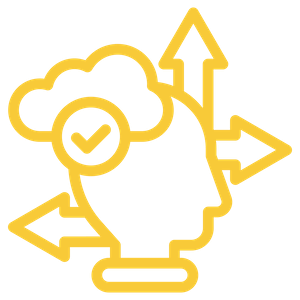Making fast decisions
Quick and quality decisions are a hallmark of high-performing leaders, teams and organisations. Fast decisions are also a pillar of strategic agility, another crucial aspect of being a high performer.
Leaders and teams with strategic agility optimise their opportunities and ideas instead of creating internal competition or trying to control outcomes. Strategic agility recognises the important of people in the success of an organisation . This improves efficiency and quality, increases capacity, lowers costs and increases profits.
A growth mindset is a contributor to strategic agility, as is fast decision-making.
During the early stages of the pandemic, companies that made rapid strategic decisions based on changing customer behaviours benefitted because their businesses could continue to meet those needs. The term “pivot”, which ultimately became a COVID cliche, is testament to the different leadership approach needed to survive extreme circumstances.
 But it’s not just during a crisis that businesses need to make rapid decisions. It’s an everyday capability that can sometimes get lost in processes that aren’t fit for purpose. Or, sometimes, staff aren’t empowered to make decisions in a timely manner. The reality is that every business success or failure is the result of a decision made or not made.
But it’s not just during a crisis that businesses need to make rapid decisions. It’s an everyday capability that can sometimes get lost in processes that aren’t fit for purpose. Or, sometimes, staff aren’t empowered to make decisions in a timely manner. The reality is that every business success or failure is the result of a decision made or not made.
Rapid decision-making is a capability that benefits organisations every day.
Blockers to making swift decisions
Harvard Business Review found that internal competition between teams was one of the most common blockers to businesses making decisions. And McKinsey found business leaders were frustrated with broken processes and the slow pace of making decisions. Fewer than half of the respondents to McKinsey’s research said decisions in their organisation were timely.
So how do we push through these blockers?
First, let me clarify that governance should not be considered as synonymous to slow decision-making. When effective, it is an extraordinary enabler for efficient organisational decisions and, additionally, provides protection from mistakes.
Here’s an example. One of my roles was as a member of the executive leadership team involved in managing a large, complex customer-facing organisation with more than 10,000 employees and 50M+ calls per year. Chartered with delivering outstanding customer outcomes, we created and implemented a new operating model and then established the supporting governance framework to ensure our decisions held true to the model. In one instance there was internal disagreement about balancing service levels and our commitments to staff development time. I negotiated with stakeholders and created a decision tree that prioritised activities based on their alignment to the principles within the model. Importantly, it also empowered the people closest to the frontline so they could make fast decisions in alignment with the governance framework.
The outcome was that we were more effective and efficient at managing service levels, maintained our core commitment to our people and supported the achievement of our strategic objectives. And this approach worked just as well during rare crises as it did in day-to-day situations.
Clarity brings trust
Companies that have clear, robust and collaborative governance frameworks typically have high levels of trust, empowered low-level staff and very clear and embedded lines of communication. They’re more efficient, which makes them perform at an even higher level during a crisis. And because governance relies on a truly collaborative framework, it enables decisions to be made by consensus. This collaboration can help push through issues like cognitive bias and bring a fresh perspective to business challenges.
A good governance framework will enable efficient and effective decisions.
There is a risk that governance becomes a box-ticking exercise or it gradually evolves to become more complex. Business leaders should review their governance approaches regularly to avoid either of these situations happening.
Essential for new businesses, too
Start-ups have glamorised the approach of moving fast and breaking things, but even new companies will benefit from a decision-making framework. It helps early-stage businesses do things right from the beginning. A light-touch governance model can help establish ways of working that create strong foundations for growth. And of course, the right framework for start-ups can ensure they can move quickly and make mistakes but remain on the right side of the law and ethics. As a new business moves into the scale-up phase, governance and frameworks become more important to help it grow quickly.
Let’s talk about how I can help your team develop a growth mindset.
FURTHER READING:
Decision-making and governance: McKinsye.com
Bain Consulting’s RAPID decision-making model: Bain.com
RAPID Framework in a nutshell: FourWeekMBA.com
Who Has the D?: How Clear Decision Roles Enhance Organizational Performance: hbr.org
Three keys to faster, better decisions: McKinsey.com







